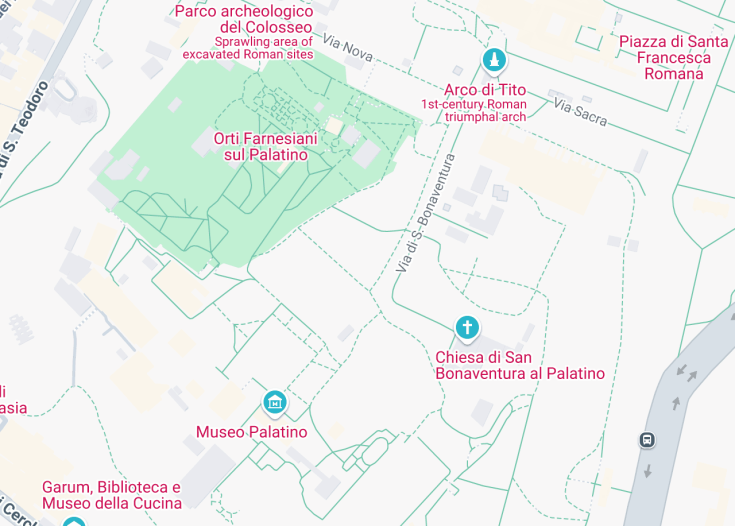Palatine Hill, one of the seven hills of Rome, is steeped in ancient history and mythology, offering breathtaking views over the city. It is believed to be the legendary birthplace of Rome, housing the ruins of imperial palaces and significant archaeological sites that reveal the grandeur of ancient civilization.
To enhance your visit to Palatine Hill, consider arriving early in the morning. This allows you to avoid the crowds and fully appreciate the serene atmosphere while exploring the stunning ancient ruins and picturesque gardens.
For an enriching experience, combine your visit to Palatine Hill with a tour of the nearby Roman Forum and the Colosseum. This will provide a comprehensive understanding of the historical significance of ancient Rome and its architectural marvels.
Palatine Hill: The Cradle of Roman Civilization
Palatine Hill, one of the Seven Hills of Rome, is steeped in myth and history. Revered as the birth site of Rome, this ancient area offers breathtaking views of the city and a glimpse into its past. Here, visitors can explore the ruins of imperial palaces, breathtaking gardens, and ancient temples, making it a crucial stop for anyone looking to understand the rich tapestry of Roman history.
As a significant archaeological site, Palatine Hill showcases remnants of the grandeur that defined the Roman Empire. It is believed to be the mythical home of Romulus and Remus, the city’s legendary founders. Walking through its timeworn pathways provides a sense of connection to the past as well as an enchanting atmosphere perfect for relaxation amidst historical wonders. With its strategic location near the Roman Forum and the Colosseum, Palatine Hill serves as an ideal starting point for any Roman adventure, making it a favorite among tourists seeking to uncover the deep roots of this magnificent city.
Exploring the Wonders of Palatine Hill
The attractions at Palatine Hill are both breathtaking and enlightening. Start your journey with the ruins of the Palace of Domitian, a sprawling complex that reflects the opulence of the Roman emperors. Another highlight is the House of Augustus, which offers a glimpse into imperial life through its stunning frescoes and artifacts.
While wandering, take your time to visit the Gardens of the Farnese, which blend natural beauty with classical architecture, providing a serene escape within the vibrant hustle of Rome. For history buffs, the Temple of Apollo is a captivating site, showcasing Roman religious practices. Whether you prefer leisurely strolls or an in-depth exploration of history, Palatine Hill promises an unforgettable experience.
Did You Know? Facts About Palatine Hill
One fascinating fact about Palatine Hill is that it was once the most exclusive residential area in ancient Rome. Only the wealthiest and most powerful residents lived here, including emperors and influential leaders. The location’s prominence signifies its importance not just as a physical space but as a symbol of power and prestige throughout Roman history.
Today, the remnants of this opulence can still be seen in the extravagant ruins, giving visitors a sense of the lavish lifestyle that characterized the early days of the Roman Empire. This rich legacy makes Palatine Hill a must-see destination for anyone passionate about exploring the ancient world.
Discover the Enchantment of Palatine Hill in Rome, Italy
Palatine Hill, one of the most iconic sites in the Eternal City, is a must-visit for history enthusiasts and casual travelers alike. Steeped in ancient lore, this famed hill is recognized as the birthplace of Rome. As visitors traverse its lush landscapes and remnants of imperial architecture, they can expect to soak in stunning views of the Roman Forum and Circus Maximus.
This historic area is particularly suitable for those who appreciate archaeology, architecture, and ancient history. With its blend of rich cultural heritage and breathtaking vistas, Palatine Hill is an ideal stop for families, education-seekers, and romantics alike, providing a splendid backdrop for memorable photographs.
The experience begins as guests stroll through the ruins of ancient palaces, including the domus of emperors and lavish villas that speak to the grandeur of Rome’s past. Aside from the historic appeal, the serenity offered by the gardens and the sense of exploration make this an enriching experience for visitors of all ages.
To enhance your visit, consider a guided tour which can offer unique insights often missed by solo travelers. Professional guides can unveil captivating stories, sharing knowledge about the mythological significance and archaeological findings of the area, deepening your understanding and appreciation of each site you encounter.
For those creating a broader tourist itinerary, Palatine Hill conveniently connects to other remarkable sites, including the Colosseum and the Roman Forum, forming a comprehensive historical route through Rome’s illustrious past.
Don’t forget to wear comfortable shoes, as the area is quite expansive, with cobblestone paths weaving through the ruins. Bring water to stay hydrated, especially on warm days, to ensure you fully enjoy the awe-inspiring surroundings.
When is the Best Time to Visit Palatine Hill in Rome, Italy?
The ideal time to visit Palatine Hill is during the spring and fall seasons when the weather is temperate, allowing for a comfortable exploration of the rich landscapes and historical sites. Early mornings are particularly enchanting, as the sun rises over the ancient ruins and fewer crowds enhance the overall experience.
Annual Events
One exceptional opportunity to visit is during the Rome Birthday Celebration in April, which commemorates the founding of the city. Special events, re-enactments, and guided tours take place, providing a once-in-a-lifetime experience immersed in local culture.
Accessibility and Limitations
While Palatine Hill accommodates many visitors, there are a few limitations to keep in mind. Paths are uneven and may pose challenges for those with mobility issues. However, efforts have been made to improve accessibility in certain areas.
Accessibility
Limitations
- Certain sections may be closed for preservation work or archaeological studies.
- Pets are not allowed in the archaeological area.
- Food and drink consumption is restricted in designated areas.
- Large bags and backpacks may need to be left at secured storage points.
Notes to visitors
- Guided tours or audio guides are recommended for a more informative experience.
- Restrooms are available on-site, but may require a short walk.
- Given the outdoor nature of the site, check the weather forecast in advance.
General Information
Details for your visit to Palatine Hill
Location
Palatine Hill is situated near the vibrant heart of Rome, surrounded by the bustling atmosphere of historical landmarks. It lies adjacent to notable sites such as the Roman Forum and the Colosseum.
Address:
Via Celio Vibenna, 00184 Roma RM, ItalyVisiting Information
Palatine Hill generally allows visitors to explore freely during operational hours, which extend throughout the day. The best times for a visit are in the morning or late afternoon to avoid peak crowds and capture the stunning light for photographs.
How to Reach Palatine Hill
Car
Palatine Hill is easily reachable by car. Public parking facilities are available nearby for a nominal fee.
| Route | Distance | Travel Time |
|---|---|---|
| From Roma Termini Station | 2.5 miles (4 km) | 15 minutes |
| From Vatican City | 3.5 miles (5.5 km) | 20 minutes |
| From Trastevere | 1.8 miles (3 km) | 12 minutes |
Public Transport
For those preferring public transport, several bus lines operate in the area, allowing easy access from various points in the city.
| Transport | Distance | Travel Time |
|---|---|---|
| Bus 81 from Termini | 2.5 miles (4 km) | 25 minutes |
| Metro Line B to Colosseo | 0.5 miles (0.8 km) | 10 minutes |
Nearby Attractions
- Roman Forum – 500 meters (0.3 miles)
- Colosseum – 1 km (0.6 miles)
- Palazzo Venezia – 1.2 km (0.75 miles)
- Capitoline Museums – 1.5 km (0.9 miles)
- Santa Maria in Ara Coeli – 1.7 km (1.1 miles)
- Campo de’ Fiori – 1.8 km (1.1 miles)
- Pantheon – 2 km (1.2 miles)
- Piazza Navona – 2.2 km (1.4 miles)
- Trevi Fountain – 2.5 km (1.6 miles)
- Villa Borghese – 2.7 km (1.7 miles)
- Spanish Steps – 2.9 km (1.8 miles)
- St. Peter’s Basilica – 3 km (1.9 miles)
Common Questions
What is Palatine Hill known for?
What are the main attractions on Palatine Hill?
- House of Augustus: This was the residence of the first Roman Emperor, Augustus, and features beautifully preserved frescoes and architectural elements.
- Flavian Palace: Also known as the Domus Flavia, this vast palace complex boasts impressive structures and gardens that showcase the opulence of Roman architecture.
- Temple of Apollo: A significant religious site dedicated to the god Apollo, this temple served both spiritual and political functions throughout the empire.
- Palatine Museum: This museum houses an extensive collection of artifacts and sculptures found during excavations, providing insights into the daily life of ancient Romans.
- Vestal Virgins’ Temple: The temple dedicated to the Vestal Virgins, who were priestesses of Vesta, offers a glimpse into the sacred practices of early Roman religion.
In addition to these key attractions, the hill itself is adorned with stunning gardens and pathways, allowing visitors to immerse themselves in the beauty and history of this legendary site. Each corner of Palatine Hill tells a unique story, transporting visitors back in time to the heart of ancient Rome.
What is the significance of the history of Palatine Hill?
What can visitors expect during a tour of Palatine Hill?
- Guided Tours: Many tour options are available, from group guided tours to private experiences, often led by knowledgeable historians who can share in-depth insights about the sites.
- Archaeological Sites: Visitors can wander through various ruins, including the remains of ancient homes and palaces, allowing a glimpse into the daily lives of the Romans.
- Scenic Views: The hill provides stunning vantage points from which to survey the Roman Forum, Circus Maximus, and the distant skyline of Rome.
- Walking Paths: Visitors can explore well-maintained pathways that guide them through lush gardens and scenic spots, perfect for quiet reflection and photography.
- Informative Signage: Interpretive signs throughout the site offer essential information about the history and significance of each location, enriching the visitor experience.
Overall, a tour of Palatine Hill is not just an exploration of ruins; it is an educational journey through time that helps visitors appreciate the awe-inspiring legacy of ancient Rome and its emperors.
What archaeological discoveries have been made on Palatine Hill?
- Imperial Palaces: The remains of grand palaces, such as the House of Augustus and the Domus Flavia, have revealed the opulence of imperial life, with intricate mosaics, frescoes, and expansive gardens.
- Ancient Streets: Archaeologists have uncovered remnants of ancient streets, which provide insights into the urban layout and daily life of Romans during the empire.
- Religious Structures: The discovery of temples and altars, including the Temple of Apollo and the Vestal Virgins’ Temple, highlights the religious practices and beliefs central to Roman culture.
- Artifacts and Objects: Numerous artifacts, including pottery, coins, and decorative objects, have been unearthed, offering a glimpse into the trade and daily living of ancient Romans.
- Evidence of Early Settlement: Findings indicate that the Palatine Hill has been inhabited since the Iron Age, supporting the historical narrative of its importance in Rome’s foundation.
These discoveries not only provide a deeper understanding of the past but also continue to shape historical narratives about political, social, and cultural dynamics in ancient Rome. Each archaeological find adds a vital piece to the puzzle of how Rome developed into one of the most influential empires in history.
What is the best time to visit Palatine Hill?

Is Palatine Hill in Rome, Italy Worth Visiting?
Palatine Hill, one of the seven hills of Rome, offers a unique glimpse into ancient Roman history and culture. Visitors can explore the ruins of emperors’ palaces and enjoy scenic views of the Roman Forum and Circus Maximus. The archaeological significance of Palatine Hill cannot be overstated, as it’s considered the birthplace of Rome itself. However, while it’s rich in history, some may find the extensive walking and uneven terrain a bit challenging. For those who appreciate history, stunning vistas, and a quieter escape from the bustling city, Palatine Hill is indeed worth a visit. Combine a trip here with a visit to the nearby Colosseum for a full immersion into Rome’s glorious past!









